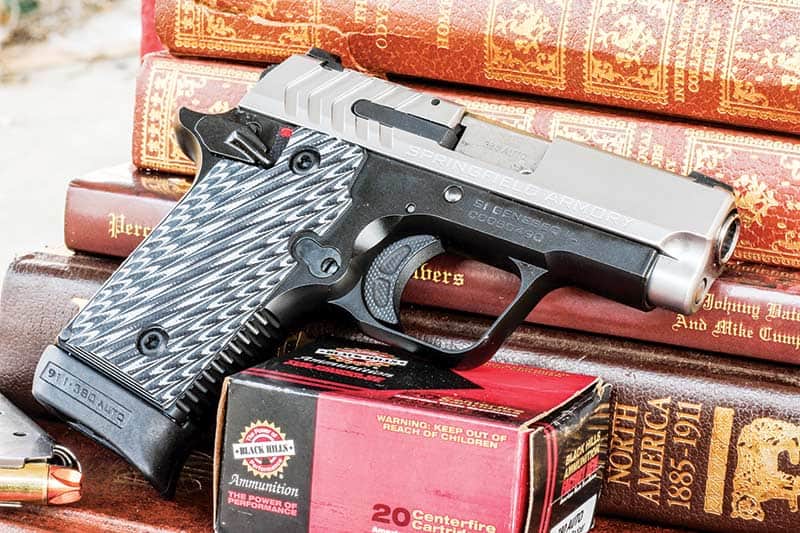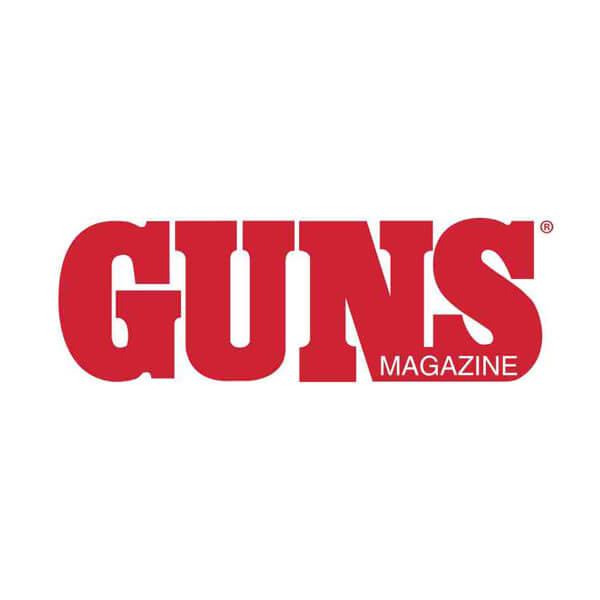Springfield 911: A CCW Shooting Star
May 23rd, 2020
4 minute read
Springfield Armory has been a significant player in the concealable handgun arena and the 911 is their first .380 — and smallest handgun — in the Springfield catalog.
The 911 has a relatively short trigger reach and the slide and frame are measurably smaller than similar 1911-ish micros from other makers. At 12.6 oz., it’s 0.8 oz. lighter than the Kimber and 2.6 oz. under the SIG 238.

The 911 features a loaded chamber indicator, a robust external extractor and a flat-wound recoil spring. The grip panels and trigger are G10. The material is lightweight and extremely tough, being produced by high pressure melding of fiberglass and epoxy.
Our sample 911 arrived as a complete CCW package riding in a zipper case complete with an owner’s manual. Two magazines are standard — a flat-base 6-round one and a 7-rounder with an extended floor plate. The magazines bear the Checkmate C.M.I cartouche — good news to those in the know about top quality mags. The pocket holster is well designed and will remain in the pocket while shielding the trigger and safety lever, keeping the pistol in position for ready acquisition.

The 911 itself is 5.5″ long, 3.9″ tall from rear sight to the base of the flat magazine and 0.85″ across at the widest part of the slide. It has positive ambidextrous thumb safeties, a passive firing pin block and a true partial-cock notch instead of the frequently substituted intermediate “step.”
Sights, Trigger
Five-shot groups from a sandbag rest from 25 yards averaged 4.3″ inches. These were from seven premium loads and ranged from 4.0 to 4.9″ — about what I get from all of the micro 1911s. The point of impact was about 4″ left and the same distance low with the exception of Buffalo Bore’s 100-gr. LFP, which hit about 4″ high and centered.
The “left and low” tendency remained the same when shooting two-handed offhand. The sights have green tritium inserts with a large, visible day-glow green front bead. Drifting the sights in their dovetails would require cautious use of a sight-pushing tool to preserve the tritium elements. The measured let-off on the trigger was right at 5 lbs. as claimed.

Ammunition Upgrade
Not too many decades ago there was but a single JHP load for the .380. It was loaded to high velocity and the bullet — pretty as it was — would expand perfectly if placed on a hard surface and struck with a 3-lb. ball peen hammer. From the standard-sized pistols of the day, it didn’t fare so well.
I wondered if current .380 loads would perform as intended from the 2.7″ of the 911, or if they’d pencil on through organic matter like an FMJ. On the average, the loads on hand lost 116 fps in comparison with the 3.6″ barrel of my Walther PPK. My assortment of 90-gr. JHP loads — SIG Elite, Hornady Critical Defense and the Hornady American Gunner (XTP) — averaged around 920 fps. The Black Hills and Fiocchi loads both launched the 90 gr. XTP to 840+ fps.
A quick and dirty protocol involves shooting into raw meat and observing expansion. I shot several bullets from my ammo assortment through beef slabs thick enough to bring them to full expansion and caught them in water jugs set behind. All of them worked consistently — pretty much like the pictures on the boxes suggested.

While I am comfortable with the performance of modern .380 ACP ammunition, Springfield Armory offers another choice. For those who don’t mind a bit more recoil, I recommend looking at the Springfield 911 in 9mm. It offers a similar size and weight but with a bit more punch from the defensive loads.
Practical Accuracy, Shootability
The Springfield Armory 911 functioned perfectly with all loads. The 7-round magazine with external base extension provided room for all fingers on the grip and the highly visible sights and optimal trigger made shooting at the usual distance for CCW qualification very easy. I fired a tight group on the head of a B-27 target standing, two-handed at a comfortable pace from seven yards and then shot five rounds each on the scoring rings from 3, 7 and 15 yards, holding right and slightly high to compensate for the deflection from zero. Looking back at targets I have shot with the other micro 1911 .380s, I found the results to be the same.
Shooting at maximum speed from 3 yards, I dumped a full magazine into the 10 and X-rings. The 911 feels more comfortable recoil-wise than my PPK and delivers repeat shots significantly faster. Just for grins, Deborah and I fired a magazine each from 25 yards from an isosceles stance. Debra used her micro carry gun while I shot the 911. We both kept our shots inside the scoring rings with the bulk of them inside the 9-ring.
Editor’s Note: This article was written by Mike Cumpston and Deborah Daviso and shared with us by GUNS magazine. You can see the original article here.
Also, please be sure to check out the new The Armory Life Forum, where you can comment about our daily articles, as well as just talk guns and gear. Click the “Go To Forum Thread” link below to jump in!
Join the Discussion
Featured in this article
Continue Reading
Did you enjoy this article?

 58
58







